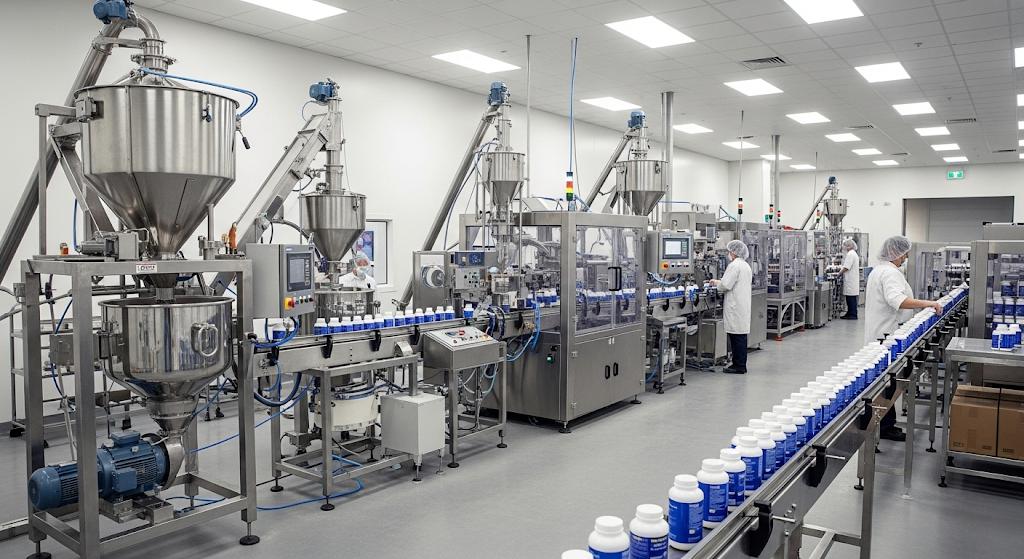The global powder supplement market is experiencing unprecedented growth, driven by consumer demand for customizable, bioavailable, and convenient nutritional solutions. For manufacturers, this dynamic landscape presents both immense opportunities and significant complexities, from scientific formulation and stringent quality assurance to regulatory navigation and efficient supply chain management. This comprehensive guide provides a strategic roadmap for powder supplement manufacturers, detailing the critical stages and considerations essential for success and sustainable growth.

1. Strategic Market Analysis & Niche Specialization
Success in the powder supplement industry begins with precision, not just volume. For B2B clients, this means more than just identifying consumer trends; it involves data-driven market analysis to pinpoint lucrative niches and unfulfilled demands.
-
Deep Dive into Market Segments: Go beyond general categories. Are you targeting sports nutrition (e.g., performance, recovery), functional foods (e.g., gut health, immunity), medical nutrition, or specialized dietary needs (e.g., vegan, allergen-free)? A focused approach allows for targeted R&D and market entry.
-
Competitive Intelligence: Analyze competitors' product portfolios, pricing strategies, and supply chain efficiencies. Identify white spaces for differentiation—perhaps through novel ingredients, unique delivery systems, or superior traceability.
-
Regulatory Foresight: Proactively assess the regulatory landscape in target markets (e.g., FDA, EFSA, Health Canada). Understanding evolving labeling, claims, and ingredient restrictions upfront mitigates costly compliance issues down the line. This informs your R&D and market entry strategy.
2. Advanced Product Formulation & Resilient Ingredient Sourcing
The heart of a superior powder supplement lies in its formulation excellence and the integrity of its supply chain. For manufacturers, this is where scientific rigor meets operational practicality.
-
Optimized Formulation Development:
-
Scientific Validation: Ground your formulations in robust, peer-reviewed science. Focus on ingredient synergy, bioavailability enhancement, and clinically effective dosages.
-
Sensory Engineering: For powders, palatability is paramount. Invest in advanced flavor masking technologies, stable natural or artificial sweeteners, and excipients that ensure superior mixability, dissolution, and mouthfeel, preventing issues like grit or clumping.
-
Stability & Shelf-Life Optimization: Develop formulations that maintain potency and integrity throughout their shelf life, considering factors like moisture sensitivity, oxidation, and ingredient interactions.
-
-
Strategic Ingredient Sourcing & Supply Chain Resilience:
-
Rigorous Supplier Qualification: Implement a multi-tiered supplier auditing program. Demand comprehensive Certificates of Analysis (CoAs) for every batch, verifying identity, purity, potency, and rigorous screening for contaminants (heavy metals, pesticides, microbial load, allergens).
-
Global Traceability: Establish end-to-end traceability systems, from raw material origin to finished product. This is critical for crisis management, quality assurance, and demonstrating transparency to your clients.
-
Risk Mitigation: Diversify sourcing where feasible. Develop contingency plans for supply chain disruptions, ensuring consistent ingredient availability and quality.
-
Cost Efficiency & Innovation: Balance premium quality with cost-effectiveness. Explore novel, high-impact ingredients that offer unique selling propositions and justify premium pricing.
-
3. Precision Manufacturing & Gold-Standard Quality Management
This is the operational core, where adherence to Good Manufacturing Practices (GMPs) is not merely compliance, but a strategic competitive advantage, ensuring consistency, safety, and efficacy.
-
State-of-the-Art Facilities & Equipment: Your manufacturing environment must exceed industry benchmarks. This includes segregated processing zones for allergen control, advanced HVAC systems for environmental stability, and specialized blending, mixing, and filling machinery calibrated for powdered products (e.g., ribbon blenders, V-blenders, highly accurate filling lines).
-
Robust Quality Management System (QMS):
-
Documented SOPs: Implement granular Standard Operating Procedures (SOPs) for every process, from raw material receipt and in-process controls to packaging and warehousing.
-
In-Process & Finished Product QC: Beyond final product testing, integrate rigorous in-process quality checks. This includes batch consistency, homogeneity, particle size distribution, and real-time fill weight verification. Conduct comprehensive finished product testing for potency, purity, stability, and absence of all contaminants.
-
Corrective and Preventive Actions (CAPA): Establish a proactive CAPA system to address deviations, non-conformances, and customer complaints, driving continuous improvement.
-
-
Validation & Calibration: All equipment, processes, and analytical methods must be regularly validated and calibrated to ensure accuracy and reliability.
-
A Culture of Quality: Foster an organization-wide commitment to quality, backed by ongoing employee training and accountability.
4. Compliant Packaging & Strategic Labeling
Packaging and labeling are your product's first impression and its ultimate regulatory safeguard. For B2B manufacturers, this involves more than just aesthetics; it’s about risk mitigation and market access.
-
Optimized Packaging Solutions:
-
Material Science: Select packaging materials (e.g., multi-layer pouches, HDPE jars) that provide superior barrier protection against moisture, oxygen, and light, crucial for maintaining powder integrity and extending shelf life. Consider eco-friendly or sustainable options where feasible.
-
Functional Design: Beyond visual appeal, focus on usability (e.g., easy-pour spouts, robust closures, integrated scoop holders) that enhance the end-user experience.
-
Scalability & Automation: Choose packaging formats compatible with high-speed automated filling and sealing equipment to optimize production efficiency.
-
-
Rigorous Labeling Compliance: This is a critical regulatory checkpoint. Ensure all labels strictly adhere to the specific regulations of target markets (e.g., FDA 21 CFR Part 111 in the U.S., EU Food Information Regulation). Key elements include:
-
Accurate Supplement Facts/Nutrition Panels: Precise declaration of ingredients and their respective dosages.
-
Allergen Declarations: Clear and unambiguous allergen statements.
-
Validated Claims: All health and structure-function claims must be scientifically substantiated and permissible under relevant regulations. Avoid unapproved disease claims.
-
Batch & Expiry Information: Clearly legible and traceable batch numbers and expiration dates.
-
5. Global Regulatory Adherence & Strategic Certifications
Navigating the labyrinthine world of global dietary supplement regulations is perhaps the most challenging, yet crucial, aspect for manufacturers. It's about ensuring market access and brand reputation.
-
Jurisdictional Expertise: Develop or access deep expertise in the diverse regulatory frameworks of your target regions (e.g., FDA in the U.S., EFSA in Europe, Health Canada, TGA in Australia). Each jurisdiction has unique requirements for ingredients, claims, and labeling.
-
GMP Certifications as a Gold Standard: While basic GMP compliance is mandatory, third-party GMP certifications (e.g., NSF, UL, TGA, BRCGS) are increasingly essential. They provide independent verification of your quality systems, opening doors to major retailers and international markets, and serving as a powerful sales tool to B2B clients.
-
Product-Specific Certifications: Strategically pursue certifications that align with your target niche and enhance marketability (e.g., Organic, Non-GMO Project Verified, Vegan/Vegetarian Society, Kosher, Halal, Informed-Sport/NSF Certified for Sport). These build trust and differentiate products in competitive segments.
-
Audit Readiness: Implement continuous audit readiness protocols, ensuring meticulous documentation and transparent processes for both regulatory inspections and client audits.
6. Strategic Marketing, Sales & Optimized Distribution
Successfully manufacturing a powder supplement is just one part of the equation; effective market penetration and efficient delivery are equally vital. For B2B, this means leveraging your manufacturing capabilities as a core service offering.
-
B2B Marketing & Relationship Building:
-
Thought Leadership: Position your company as an industry expert through white papers, webinars, and participation in industry conferences (e.g., SupplySide West, Vitafoods).
-
Targeted Outreach: Utilize professional networks (e.g., LinkedIn), industry directories, and direct engagement with brands, formulators, and distributors.
-
Showcase Capabilities: Clearly articulate your manufacturing capabilities, capacity, quality control prowess, and innovation pipeline to potential clients.
-
-
Client Engagement & Partnership Models:
-
Contract Manufacturing: Offer end-to-end production for clients who provide their own formulations.
-
Private Label Solutions: Provide pre-formulated, customizable products under the client's brand.
-
Formulation Support: Offer R&D expertise to help clients develop unique products.
-
-
Streamlined Distribution & Logistics:
-
Efficient Warehousing: Maintain climate-controlled, secure warehousing to protect product integrity.
-
Scalable Fulfillment: Partner with experienced 3PL (Third-Party Logistics) providers specializing in dietary supplements to handle storage, picking, packing, and shipping efficiently, allowing you to focus on core manufacturing.
-
Global Logistics Expertise: Navigate international shipping regulations, customs, and freight optimization to support client distribution worldwide.
-
7. Continuous Improvement & Client-Centric Innovation
In a rapidly evolving market, the ability to adapt, innovate, and continuously improve sets leading manufacturers apart. This commitment fosters long-term client partnerships.
-
Closed-Loop Feedback Systems: Establish robust mechanisms for collecting, analyzing, and acting on client feedback, market trends, and regulatory updates.
-
Agile R&D: Foster an agile research and development pipeline that can quickly respond to emerging scientific insights, new ingredient discoveries, and shifting consumer preferences, enabling rapid product iteration and new product launches for your clients.
-
Technology Integration: Embrace automation, AI, and data analytics to optimize production processes, predict demand, manage inventory, and enhance overall operational efficiency.
-
Proactive Regulatory Monitoring: Dedicate resources to continuously monitor and interpret changes in global dietary supplement regulations, providing proactive guidance and solutions to your clients.
-
Strategic Partnerships: Forge stronger alliances with raw material suppliers, technology providers, and logistics partners to enhance capabilities and offer integrated solutions.
Conclusion
Mastering powder supplement manufacturing is an intricate dance of scientific precision, operational excellence, and unwavering commitment to quality and compliance. For manufacturers, a comprehensive approach—from meticulous market analysis and advanced formulation to rigorous GMP adherence, strategic regulatory navigation, and efficient distribution—is non-negotiable. By embracing continuous improvement and positioning themselves as strategic partners, powder supplement manufacturers can not only meet the escalating demands of the health and wellness industry but also secure a resilient and prosperous future.






